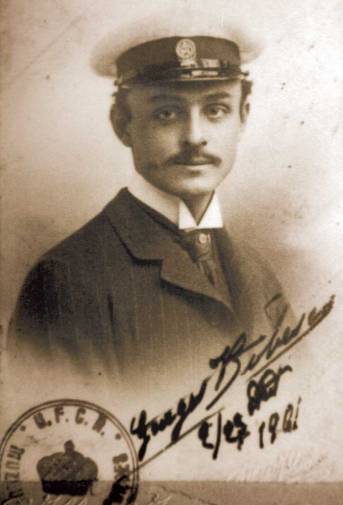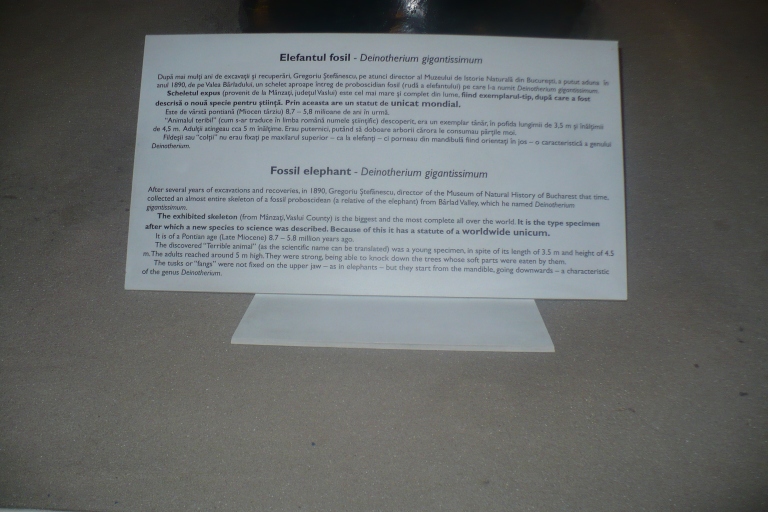Romanian Achievements and Records: Part 14
91. In 1890’s Romania, scientist Gregoriu Ştefănescu, director of the Museum of National History of Bucharest at the time, discovered the biggest and the most complete skeleton of a prehistoric elephant in the world, as is has remained until these days. It was collected from Vaslui County and is the type specimen after which a new species to science was described. Because of this it has a statute of a worldwide unicum.
As BBC reported at a fossil discovery in Britain, ‘it is very rare for scientists to find a fossil which is almost complete’.
The world’s biggest and most complete prehistoric elephant skeleton can be found in Bucharest, at the Grigore Antipa Museum of Natural History
It is of a Pontian age (Late Miocene) 8.7 – 5.7 million years ago. The discovered ‘Terrible animal’ (as the scientific name, Deinotherium, can be translated) had a length of 3.5 m and a height of over 4.5 m.

The elephant skeleton from the Grigore Antipa Museum of Natural History, a worldwide unicum
- the card with information that can be found in the direct source, namely the National Museum of Natural History in Bucharest
92. The Benois de la Danse is one of the most prestigious ballet competitions in the world. Founded by the International Dance Association in Moscow in 1991, it takes place each year and is jury-based in its judging. Its most important prize is often called ‘the ballet Oscar’. But why are we telling you all these?
Well, in 2012, Romanian ballet dancer Alina Cojocaru became the first ballerina to receive the Prix Benois de la Danse twice, after she first won it in 2004. This achievement confirmed her longevity, her great value and also, her place as a leading figure in the world’s contemporary ballet. (sources 1, 2)

Alina Cojocaru, the first and only female ballet dancer to win ‘the ballet Oscar’ twice

Alina Cojocaru, a world-famous ballet dancer
93. Romanian prince, aviation pioneer and automobilist George Valentin Bibescu founded in 1913 the first reconnaissance squadron that took off in wartime in the world. (sources 1, 2, 3)

Prince George Valentin Bibescu
In 1912, the Cotroceni Piloting School was established at the initiative of George Valentin Bibescu. It was the base for what remained in history as the “Recognition Squadron”, the first ever in the world that took off during a war, which he personally led in the Second Balkan War. “Romania is above all, and Romania means us, Romanians. Believe me, we have reasons to sacrifice!”, he once told his students.
On the front of Bulgaria had taken action 19 Romanian airplanes which overflown Sofia, just above the Royal Palace courtyard. Aviators Nicolae Capşa, Ioan H. Arion, Constantin Fotescu and prince Gheorghe Valentin Bibescu made reconnaissance flights over distances of 200 km and at heights of 2200-2500 m, true achivements for those times of aviation pioneering.

Prince George Valentin Bibescu (left) being decorated by Marshal Alexandru Averescu
94. The Royal Albert Hall is one of the most famous concert halls in the world. Opened by Queen Victoria in London, England, it has a history of over 140 years.
The world’s leading artists from several performance genres have appeared on its stage and it has become one of the UK’s most treasured and distinctive buildings. Each year it hosts more than 350 events including classical concerts, rock and pop, ballet and opera, sports, award ceremonies, school and community events, charity performances and banquets.

The Royal Albert Hall
Well, among the thousands of artists that have performed on its stage over almost a century and a half, in the hundreds of events that it hosts each year, there was something lacking.
In 2013, Romanian pianist Alexandra Dariescu became the first female pianist to ever perform at the Royal Albert Hall. Yes, the first in 142 years! (source)

Acclaimed Romanian pianist, Alexandra Dariescu

Alexandra Dariescu, featured as BBC Music Magazine’s Rising Star in June 2011
95. ‘Sonata No. 2 for Violin and Piano in F minor‘ by Romanian composer George Enescu is regarded as one of the greatest sonatas of all time. (sources 1-page 25, 2)

George Enescu, one of Romania’s greatest icons
In this sonata, finished when Enescu was only 18, in 1899, the melody is free, without any barriers between themes, and all other elements (harmony, polyphony, form) are derived from it or help its development; the main theme is introduced in unison; the melody oscillates between major and minor, and is transformed by getting the two distinct main themes closer together gradually until they end up continuing each otherin a natural way.

George Enescu
- Carl Flesch, renowed 20th century Hungarian musician, stated:
| It is one of the most important works in the whole Sonata literature, and one that is most unjustly and entirely neglected. |
- On other ocassion, Flesch stated that this sonata is:
| […] amongst the most powerful contemporary works in this area. The emotional content and the technical mastery are at the same high level, and from the melodic and also harmonic viewpoint, it appearsto us as new even today, untouched and captivating. At that time, he [Enescu] was considered a man of the future not only of Romania but also of the whole musical world, as a unity factor between the German (Brahms) and the French (Franck‐Debussy) traditions. |
- George Enescu declared the following in his Memoires:
| With the Second Violin Sonata and with the String Octet I felt that I am evolving fast, that I become my own self. Sometimes I would tell myself ‘It’s like I am a Berlioz in chamber music’, if one could imagine the man with five reunited orchestras writing for this kind of musical genre… In any case, starting with that Sonata, I have become my own self. Until then I was searching and trying. From that moment on, I felt capable to walk on my own two feet, even to run fast. |
Sonata nr.2 for violin & piano in f minor op.6 C by George Enescu
